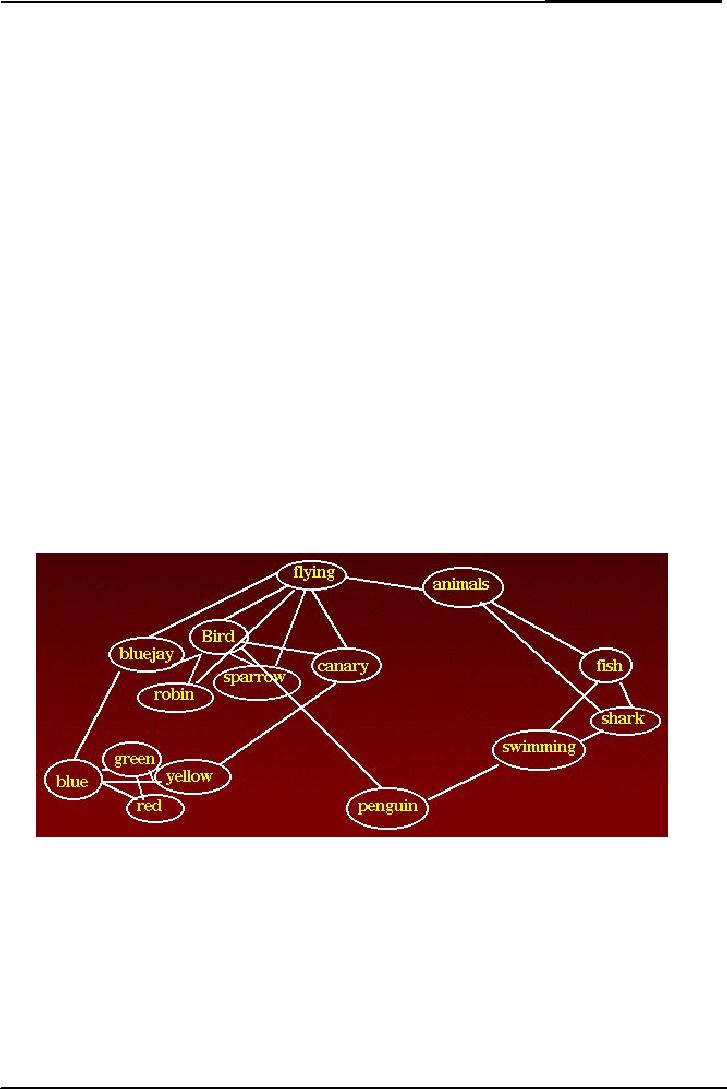 |
Memory:Activation in a network, Magic number 7, Chunking |
| << MEMORY:Rate of forgetting, Size of memory set |
| Memory:Chunking, Individual differences in chunking >> |

Cognitive
Psychology PSY 504
VU
Lesson
25
Memory
Short
Term Working
Memory
Short
term memory and Working
Memory are same. Some
psychologists distinguish short
term
memory
and working memory but
majority of Psychologist Do not.
Another important thing
in
memory
is Attention. Attention plays an
important and critical role
in short term memory.
Duration
of
short term memory is about
20 seconds. Working Memory is a
memory that we use to
function.
Not
the same thing as
remembering what happened
yesterday as opposed to a long
time ago.
The
conscious is short term
memory. Long Term Memory is
an infinite storehouse. After
20
seconds
what we can remember is long
term memory. So, short
Term Memory is limited
in
capacity.
Working
Memory: an activation
model
John
Anderson worked a lot on
parallel process. He presented
this activation model and
said
working
memory sees short term
and Long term memory as
qualitatively different. But
some
other
psychologists see LTM and STM
similar but with some
differences. There are
certain
differences.
According to activation model
working memory has something
which has a certain
level
of activation (above threshold).
Outside information is also
involved in this activation
model.
The
items in working memory are
defined by a high level of
activation, which enables
reliable and
rapid
access to them. Attention is a
part and parcel of this
activation mechanism off
short term
working
memory. Attention relies on
rehearsal. There is limitation in
Short term memory
rehearsal.
If unattended the items in
working memory will rapidly
decay away in their level
of
activation.
One can maintain items in
working memory by rehearsing
them and keeping them in
a
highly
active state. There are
limitations on how many
items one can rehearse
before they decay.
Activation
in a network
This
is a network of words. We can
say this is a semantic
network. Different words
with links are
presented.
Like at bottom there is a
word penguin. This word
has two direct links
swimming and
bird.
These two words have
other links like shark,
flying, animals, fish, and
sparrow. This is a
network
of long term memory. These
networks help in the
activation of short term
memory.
For
example, if there are some
concepts related to penguin
like sea, atmosphere then we
can
recognize
this penguin.
If
we are seen desert we can
remember camels. Because we
are used to see camel in
desert.
So,
these all information is
saved in our long term
memory, with clues we can
remember things
like
camel in desert. So the
effect of context is also
very important even in
working memory
because
it active other related
nodes.
75

Cognitive
Psychology PSY 504
VU
Magic
number 7
John
Miller was a great cognitive
psychologist. He presented model of
memory.
He
wrote in an article,
"My
problem is that I have been
persecuted by an integer. For
seven years this number
has
followed
me around, has intruded in my
most private data, and
has assaulted me from
the
pages
of our most public journals.
This number assumes a
variety of disguises,
being
sometimes
a little larger and
sometimes a little smaller
than usual, but never
changing so
much
as to be unrecognizable. The persistence
with which this number
plagues me is far
more
than a random accident.
There is, to quote a famous
senator, a design behind it,
some
pattern
governing its appearances.
Either there really is
something unusual about the
number
or
else I am suffering from
delusions of persecution."
This
number is 7. He said it is very
important. It is limit of items
how many items we can
keep in
our
memory. Plus minus 2 is
range of 7.some people can
remember 5 numbers and some
can
remember
9 numbers. It means 7-2=5,
7+2=9.
We
can understand this by an
example. We give a list of 7
digits to our friends for
remembering. It
is
normal if people can recall
5 and 7 digits. But if
people can recall less
than 5 then there is
some
problem
with these people. Some
people have good memory
they can recall 9
digits.
If
we look in our religion we
have seven days in our
week. There are seven
seas, seven
continents,
and seven skies. So 7 is our
limit of our short term
memory.
A
question arises here, that
is people can learn more
than 7 words, 7 letters,
seven sentences.
These
seven letters LJKWNPR are
easy to learn. But if this
list of cities,
London,
Paris, Munich, Berlin,
Madrid, Prague, Stockholm, is
given to people. People can
learn it.
So,
how interesting people can
learn these 40 digits? So,
magic number & is not
physical unit it is
semantic
unit or meaningful
unit.
An
example of all this can
be, you are in a market
and watching shirts, you
like 30 shirts but
you
can
remember only 7 or 8 shirts in
short term memory at a same
time. Some people
collect
samples
and then select the
best possible from these
samples.
In
decision-making, need for
awareness of limitations of Short
Term Memory. Our long
term
memory
has a long storage capacity
but our short term
memory is limited. That's
why people
need
to keep diaries. They note
all important things in
these diaries. Because our
short term
memory
does not have
capacity.
Chunking
There
is another way of remembering
things that is
chunking.
For
example a telephone Number in USA is
6174927861. this number has
more than 9 digits. It
is
not
easy to recall it. So the
easy way to remember this
number is chunking.
Like
617-492-7861
In
Pakistan people make chunks
in different way than USA
like,
617-49-27-861
But
some time problem can
arise when we tell phone
numbers to a person who has
different way
of
making chunks. Like some
recall three by three
digits, some recall digits
two by two. So other
can
face problem in remembering
others chunks.
Chunking
is a way to increase capacity.
Capacity of STM varies with
meaningfulness of the
material.
A chunk is a memory unit. STM
capacity is not limited by a
physically defined unit but
by
a
meaningfulness unit. Through
chunking we can learn 21
digits at a time. Words
limit is seven.
But
the capacity of sentence is
much lower than letters
and words.
76
Table of Contents:
- INTRODUCTION:Historical Background
- THE INFORMATION PROCESSING APPROACH
- COGNITIVE NEUROPSYCHOLOGY:Brains of Dead People, The Neuron
- COGNITIVE NEUROPSYCHOLOGY (CONTINUED):The Eye, The visual pathway
- COGNITIVE PSYCHOLOGY (CONTINUED):Hubel & Wiesel, Sensory Memory
- VISUAL SENSORY MEMORY EXPERIMENTS (CONTINUED):Psychological Time
- ATTENTION:Single-mindedness, In Shadowing Paradigm, Attention and meaning
- ATTENTION (continued):Implications, Treisman’s Model, Norman’s Model
- ATTENTION (continued):Capacity Models, Arousal, Multimode Theory
- ATTENTION:Subsidiary Task, Capacity Theory, Reaction Time & Accuracy, Implications
- RECAP OF LAST LESSONS:AUTOMATICITY, Automatic Processing
- AUTOMATICITY (continued):Experiment, Implications, Task interference
- AUTOMATICITY (continued):Predicting flight performance, Thought suppression
- PATTERN RECOGNITION:Template Matching Models, Human flexibility
- PATTERN RECOGNITION:Implications, Phonemes, Voicing, Place of articulation
- PATTERN RECOGNITION (continued):Adaptation paradigm
- PATTERN RECOGNITION (continued):Gestalt Theory of Perception
- PATTERN RECOGNITION (continued):Queen Elizabeth’s vase, Palmer (1977)
- OBJECT PERCEPTION (continued):Segmentation, Recognition of object
- ATTENTION & PATTERN RECOGNITION:Word Superiority Effect
- PATTERN RECOGNITION (CONTINUED):Neural Networks, Patterns of connections
- PATTERN RECOGNITION (CONTINUED):Effects of Sentence Context
- MEMORY:Short Term Working Memory, Atkinson & Shiffrin Model
- MEMORY:Rate of forgetting, Size of memory set
- Memory:Activation in a network, Magic number 7, Chunking
- Memory:Chunking, Individual differences in chunking
- MEMORY:THE NATURE OF FORGETTING, Release from PI, Central Executive
- Memory:Atkinson & Shiffrin Model, Long Term Memory, Different kinds of LTM
- Memory:Spread of Activation, Associative Priming, Implications, More Priming
- Memory:Interference, The Critical Assumption, Limited capacity
- Memory:Interference, Historical Memories, Recall versus Recognition
- Memory:Are forgotten memories lost forever?
- Memory:Recognition of lost memories, Representation of knowledge
- Memory:Benefits of Categorization, Levels of Categories
- Memory:Prototype, Rosch and Colleagues, Experiments of Stephen Read
- Memory:Schema Theory, A European Solution, Generalization hierarchies
- Memory:Superset Schemas, Part hierarchy, Slots Have More Schemas
- MEMORY:Representation of knowledge (continued), Memory for stories
- Memory:Representation of knowledge, PQ4R Method, Elaboration
- Memory:Study Methods, Analyze Story Structure, Use Multiple Modalities
- Memory:Mental Imagery, More evidence, Kosslyn yet again, Image Comparison
- Mental Imagery:Eidetic Imagery, Eidetic Psychotherapy, Hot and cold imagery
- Language and thought:Productivity & Regularity, Linguistic Intuition
- Cognitive development:Assimilation, Accommodation, Stage Theory
- Cognitive Development:Gender Identity, Learning Mathematics, Sensory Memory